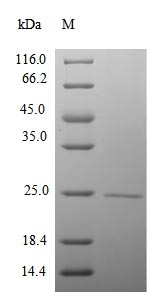Recombinant Mouse RNA polymerase II subunit A C-terminal domain phosphatase (Ctdp1) is expressed in E. coli and covers the amino acid region 178-341. This partial protein comes engineered with an N-terminal 10xHis tag and a C-terminal Myc tag, which makes purification and detection more straightforward. SDS-PAGE analysis confirms the product shows purity greater than 90%, suggesting high-quality performance for research applications.
Ctdp1 appears to be a crucial phosphatase involved in regulating RNA polymerase II. It plays what seems to be a significant role in transcriptional processes. The protein is known for dephosphorylating the C-terminal domain of RNA polymerase II, which likely influences transcription elongation and termination. Understanding this protein may be essential for transcriptional regulation studies and their broader implications in gene expression research.
Potential Applications
Note: The applications listed below are based on what we know about this protein's biological functions, published research, and experience from experts in the field. However, we haven't fully tested all of these applications ourselves yet. We'd recommend running some preliminary tests first to make sure they work for your specific research goals.
Mouse Ctdp1 is a eukaryotic phosphatase that requires precise folding, proper active site formation, and specific tertiary structure for its functional activity. The E. coli expression system cannot provide the eukaryotic folding environment or post-translational modifications that may be important for this phosphatase. The partial fragment (178-341aa) lacks critical domains of the full-length protein, and the dual N-terminal 10xHis-tag and C-terminal Myc-tag may cause significant steric interference with the protein's active site and functional domains. The probability of correct folding with functional phosphatase activity is extremely low.
1. Antibody Development and Validation
This application has limited utility. While antibodies can be generated against this specific 178-341aa region, they will not recognize conformational epitopes of the full-length phosphatase. Antibodies may primarily target the foreign tags rather than the protein domain.
2. Structural and Biophysical Characterization
Basic biophysical analysis can be performed, but will not reflect native Ctdp1 structure. The tags will dominate the protein's physical properties, and the results will describe an artificial construct rather than the physiological phosphatase.
Final Recommendation & Action Plan
This dual-tagged Ctdp1 partial fragment expressed in E. coli is unsuitable for functional studies due to the essential requirements for proper folding and phosphatase activity that cannot be met in this system. The protein should not be used for activity assays and interaction studies. Application 1 (antibody development) has severe limitations and will likely produce tag-specific antibodies. Application 2 provides only basic characterization of the tagged fragment. For reliable Ctdp1 research, use a full-length protein expressed in eukaryotic systems that supports proper folding and preserves functional phosphatase activity.






